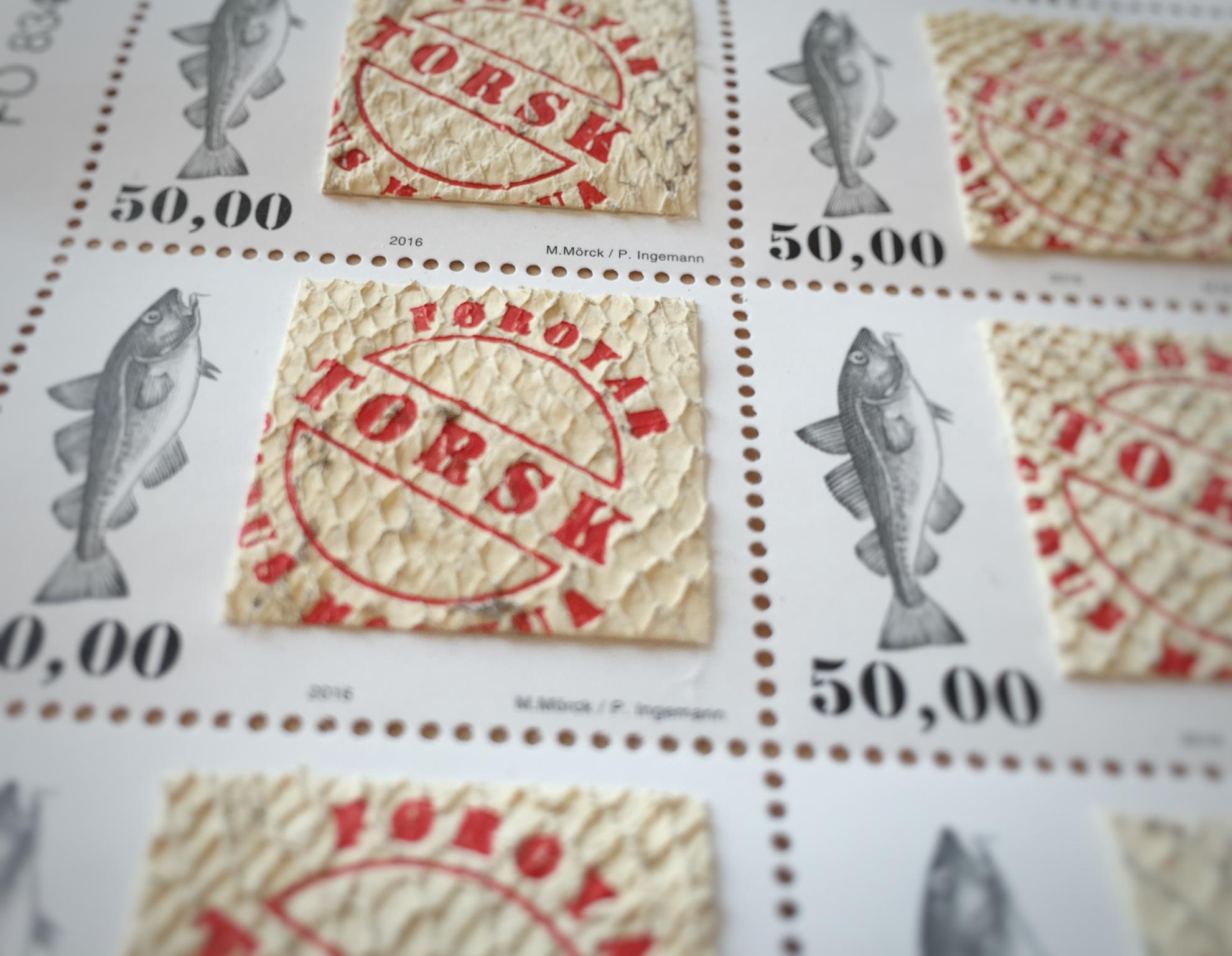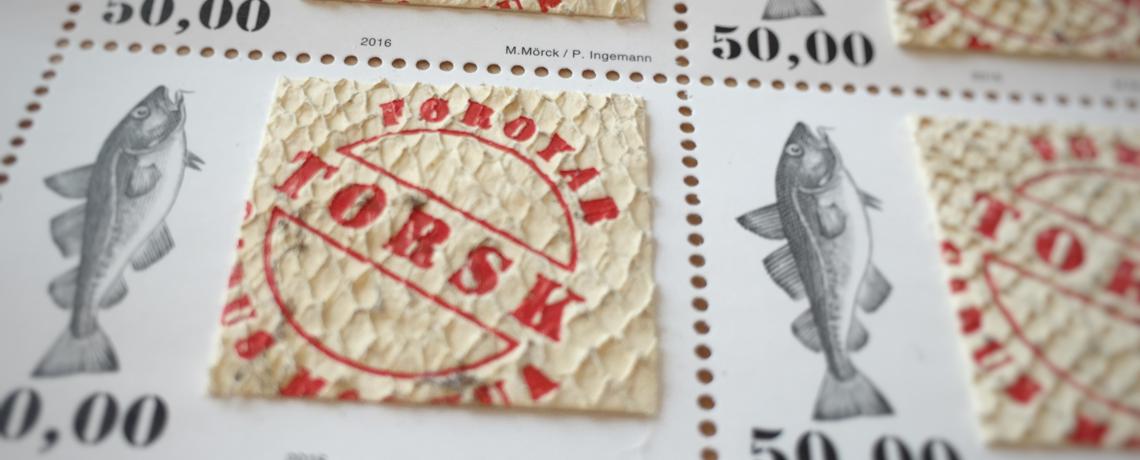Året 2016 har inneburit att flera spännande frimärken har utkommit på Färöarna, inklusive en verklig innovation i sammanhanget. Ett unikt märke med äkta handarbete.
Som brukligt de senare åren har utgivningen fördelat sig på ett antal utgivningstillfällen på våren och ett tillfälle på hösten. Sammanlagt har 25 olika motiv avbildats på frimärken och fyra motiv på s.k. portomärken. Förutom enstaka frimärken, har det kommit ut tre miniark och tre häften.
22 FEBRUARI
Brandbilar
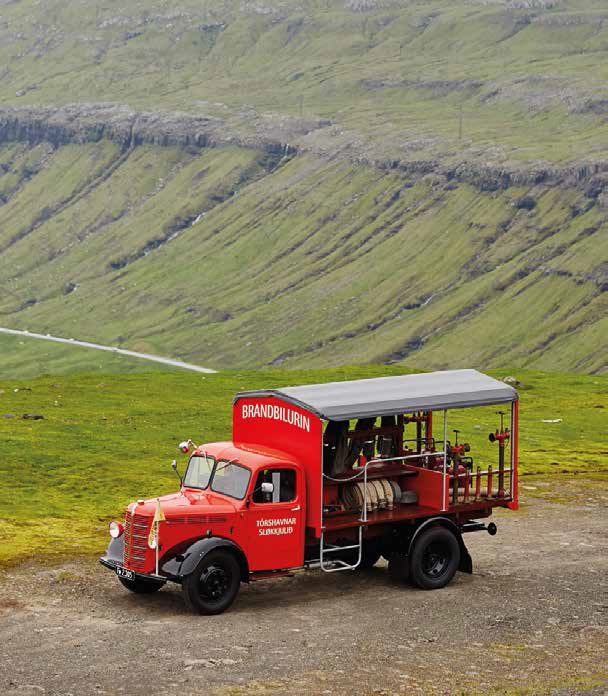
Första utgivningstillfället var den 22 februari, då det kom ut sex frimärken, ett miniark och ett häfte. En serie på tre märken avbildar historiska brandbilar som varit i bruk på Färöarna. Valörerna är 1, 15 och 19 kr och märkena kom ut såväl i ark med 20 märken i varje som i ett häfte med två märken av vardera valör. Märkena är tryckta i Kanada efter fotografier av Martin Sirkovsky.
Ostindiefararen
År 1742 led den holländska ostindiefararen Westerbeek skeppsbrott väster om Lopra på Suðuroy. Till minne av denna händelse utkom två märken i valörerna 17 och 19 kr och därtill ett miniark med de båda märkena. Dessa är formgivna av Anker Eli Petersen och tryckta i Nederländerna. Det var också i Nederländerna, närmare bestämt i Rotterdam, som märkena presenterades för allmänheten vid en särskild tillställning på utgivningsdagen. 110 färöingar åkte till Nederländerna i samband med presentationen av frimärkena och det blev möten mellan färiöngar och holländare som är släkt.
Om den holländska ostindiefararen Westerbeek skeppsbrott, har Anker Eli Petersens skrivit denna historia :
The Wreck of Westerbeek
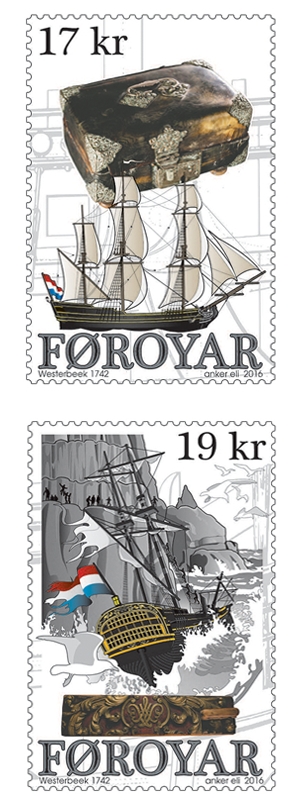
There were some factors worrying Westerbeek‘s young captain when he took over the evening watch on September 2, 1742. The ship had been at sea for more than seven months after leaving Batavia – now Jakarta in Indonesia - on January 27. After a stopover in Punte Gale in Ceylon where the last cargo was loaded, the great East Indiaman called into port at Cape Town on April 22 with its hold full of tea and nutmegs bound for the European market. Cape Town at the southern tip of Africa served as a sort of halfway station for Dutch ships bound for the Far East and Europe, Westerbeek left Cape Town on May 11 in a convoy of seven other freighters owned by the Dutch East India Company.
Circumstances are unclear but it appears that en route from Cape Town the ships lost sight of each other. It subsequently became clear that only five of them reached their destination in Holland safely.
On August 20th Westerbeek ran into dense fog which did not lift for more than a week. In order to determine the exact position it was necessary to measure the sun‘s altitude. The intention was to sail north and west of Scotland to the North Sea, following the Danish west coast towards Holland. At noon on September 2 Captain Herman Schutte estimated along with other navigators that they were 252 nautical miles northwest of the Hebrides and 224 nautical miles southwest of the Faroe Islands. It was decided that it was time to turn east-south-eastward in order to pass north of the Shetlands and head in the direction of mainland Europe. A stiff breeze was blowing from the west and the ship kept going at 13 knots under full sails.
Doubts kept nagging Captain Schutte when he took over the watch at 8 o'clock in the evening of September 2. He worried about the unreliable altitude measurements and was unsure of how far north they really were. He gave orders to reef the small sails and trim the large ones in order to reduce the ship's speed.
The good captain had ample reasons to be concerned. Due to lacking position measurements and exceedingly strong currents following new moon, the ship had veered far off course. It had actually strayed more than 48 miles to the north and 108 nautical miles to the east, far from the estimates of the navigators at noon. Instead of sailing towards mainland Europe, Westerbeek headed straight towards the rugged and inaccessible west side of the Faroe Islands.
The third officer, Bernardus Riebock, stood at the helm. There were two lookouts, one in the prow and the other in the foremast cage. Everything was quite calm and nothing seemed out of the ordinary. The captain stood in the chart house mulling over the nautical charts, the officer at the helm had turned the hour-glass for the fourth time which meant that it was approximately ten or half past ten in the evening and the night was pitch black.
And then, like a bolt from a clear blue sky, disaster struck.
"Land ... land ahead", the lookouts shouted. The captain jumped onto the deck and saw to his horror a huge promontory rise against the black sky, approximately 95 meters away from the ship. The uppermost point of the promontory could not be distinguished - there was no shore to be seen and the waves broke directly on the bare cliff face. Captain Schutte ordered the helm hard-a-starboard and sails were reversed, but it was too late. The ship‘s port side struck the cliffs.
What followed was a desperate, several hours long life-and-death battle with the elements. The crew tried to get away from the cliffs with the help of the headsails, but the ship was tossed back and forth by the surf, wind and current. At half past eleven the raised deck bow hit the cliffs, breaking the bowsprit which disappeared into the waves. Then the head sails were lost. At the same time the ship sprung a leak. With water rising up to about 6 feet (about 180 cm) in the hull, all pumps were manned and spouted continuously, yet water levels aboard kept rising.
Westerbeek was now completely at the mercy of the elements, and the crew lost hope of escaping alive from the wreck. The ship crashed repeatedly against the rock face and the figurehead (the structure mounted on the bow of the ship – shown on the right-hand side of the stamp sheet) was torn off. At the same time the prow suffered still further damages and parts of the superstructure aft were crushed.
At one o'clock at night the front mast broke and fell over the port side. No one was hurt when the mast was catapulted overboard, but now the ship drifted further ending up between the cliff face and four skerries just offshore. The ship still beat against the rocks and in order to keep the rear free, an aft anchor was dropped. At the same time they placed the yardarm on the main mast (the cross-beam which holds up the mainsail) in a square, i.e. crosswise across the ship's length, to steady the ship against the rock wall. It was probably during this work that the crew noticed what miraculously was to save their lives - a narrow ledge on the otherwise steep cliff face.
At this point in time the ship was starting to break up. Prow, stern and rudder had been shattered and the pumps could no longer keep it afloat. The captain gave order to vacate ship and the crew climbed the mainmast, the yard and onto the narrow ledge. Captain Schutte took the little casket in which the ship's documents and port charges were kept and asked the steward to take it ashore. Then, according to the story, he went down to the cabins to get his son, who along with ten others lay ill below deck. The captain took his son on his back and climbed the mast, but when he tried to scale the yard over to the shore, he lost his grip on the boy who plunged down and was killed on the deck.
The entire crew, except for the bedridden men below deck, saved themselves upon the narrow ledge. Here they discovered the next big hurdle – the next mountain ledge was too far up. Hence, some of the crew went back on board and brought four oars and some ropes. This material was used to construct a makeshift ladder on which one of the men managed to reach the next ledge. The next to climb the ladder was chief steward who was carrying the captain's casket. He had difficulties holding onto the very steep ladder and plunged into the ocean along with the casket containing the ship documents and the crew‘s only money. According to the story, the first sailor to get up, tore his shirt into pieces and made a rope of strips, lowering it down to help the next man scale the ladder - thus, all the men were able to reach the ledge.
There they remained the rest of the night, watching their ship break apart until, at 7-8 o'clock in the morning, it keeled over to the port side and disappeared in the surf.
At daybreak the fog drifted away and the crew could see their surroundings. They had no idea where they were, possibly in the Hebrides or Shetland - but clearly they had to get immediate help. Eight of the ablest men decided to climb the cliffs and seek assistance. It was an arduous ascent of more than 100 meters - and when they got up, they saw no traces of people or houses. They could, however, see a path going from north to south, so they decided to split up with four of them walking in each direction.
In the morning, those heading north arrived in Vágur. Having convinced the inhabitants that they were not pirates, they got ready help from the locals who were accustomed to hunting birds in the mountains. They brought their bird lines and together with the Dutch seamen they went back to Lopranseiði where the Faroese rappelled down and started hauling the desperate castaways up from the cliffs. Later, people from Sumba also arrived, having been alerted by the southbound group. Soon all survivors of the Westerbeek wreck had been rescued.
The rest is history. A total of 81 men miraculously survived the wreck. The following day they were transported to Torshavn where a maritime inquiry was held. Although two ships belonging to the Royal Trade Monopoly were stationed in Torshavn, the captains refused to take all the distressed mariners with them to Denmark. Only the captain, senior officers and a few of the crew, a total of ten men, were allowed to return - the rest of Westerbeek‘s crew was spread throughout the islands while they waited for one of the East India Company ships to come to get them. It took nine months before the Dutch vessel Mercurius called into port in Torshavn and the crew was finally able to go back home. Only one of Westerbeek‘s crew stayed behind in the Faroe Islands. This was the ship's surgeon Joseph Gewording von der Schild, who married a local woman and was employed as a country surgeon.
Debris from the wrecked ship began drifting ashore in the Faroes, among them bales with damaged tea plants and spices, especially pepper, wine kegs, coffins and boxes with clothes, not to mention fragments of the ship itself. Some of these things still exist, among them the small casket made of tortoise shell, depicted on the stamp. Whether this is the same casket that the chief steward clutched in his hand when he fell from the cliffs, is uncertain but it was probably of a similar kind.
The second item that we have chosen to depict on the stamp is a wooden ironing board. The wood comes from Westerbeek's ornamental decoration. Its origin is probably the ship's emblem, which was carved on the hedge. Apart from that, it is a quaint idea that a generation of Faroese women have been smoothing out wrinkled clothing with a piece of the stern of a historic East Indiaman of the "hekboot" type.
The history of Westerbeek's wreck is unique in many ways. The fact alone that almost the entire crew would survive a collision with one of the most inaccessible promontories on the Faroe Islands' inhospitable west side, is an unparalleled event. The fact that some of them even managed to climb up the steep cliffs of Lopranseiði where even experienced Faroese rappelers with local knowledge are averse to go, is nothing short of an achievement.
The year 2008 saw the publication of a book on Westerbeek's shipwreck, written by Mathias Lassen. The book is available only in Faroese, but parts of the numerous contemporary source documents, are written in Danish.
Strandskator
Den tredje utgåvan i februari var ett enstaka märke avbildande strandskator och symboliserande vårens ankomst. Valören är 17 kr, märket är formgivet av Edward Fuglö och tryckt i Frankrike. Märket är utgivet i ett samarbete mellan små europeiska postverk (SEPAC – Small European Postal Administration Cooperations), vars medlemmar årligen ger ut frimärken på ett givet tema. 2016 års tema var ”årstider”.
1 APRIL
Den 1 april firade det färöiska postverket 40-årsjubileum och det uppmärksammades med ett frimärke och ett miniark med två motiv. Niokronorsvalören finns både som enstaka frimärke och ingår i miniarket och avbildar den blå postlåda som introducerades på Färöarna i samband med övertagandet av postverket. Ett 17-kronorsmärke ingår i miniarket och avbildar den röda danska postlådan som använts även på Färöarna fram till 1976. Märke och miniark är tryckta i Frankrike.
29 APRIL
Den 29 april utkom två frimärken. Det ena uppmärksammade 250-årsminnet av Nólsoyar Pálls födelse och det andra var ett motiv på ett samnordiskt tema – matkultur.
Nólsoyar Páll, eller Poul Poulsen Nolsöe (1766-1809), räknas som en nationalhjälte på Färöarna. Han var sjöman, båtbyggare, uppfinnare, bonde och nationaldiktare. Märket är vackert graverat av den svenske gravören Martin Mörck efter en målning av Archibald Black och har valören 24 kr. Märket är tryckt i Frankrike.
De nordiska länderna gav under 2016 ut frimärken på det gemensamma temat matkultur. Det färöiska frimärket visar en typisk färöisk visthusbod – hjallur. Valören är 9 kr och märket är tryckt i Frankrike.
9 MAJ
Den 9 maj, Europadagen, var det dags för en utgåva med två frimärken på ett gemensamt europeiskt tema – grön energi. Det ena märket, i valören 17 kr, är gemensamt för flertalet europeiska länder, medan märket i valören 9 kr är särskilt för färöarna och formgivet av Edward Fuglö. Märkena trycktes i Österrike och utkom även i ett häfte med tre märken av varje.
26 SEPTEMBER
Den 26 september såg tre utgåvor dagens ljus. En av dem var en verklig världsnyhet!
Men först: Två märken, i valörerna 17 och 20 kr, avbildar detaljer från den manliga respektive kvinnliga färöiska nationaldräkten. Edward Fuglö har formgivit märkena som är tryckta i Österrike. Förutom i ark har märkena även utkommit i häfte med tre märken av varje.
Ett ark med 10 märken i valören 9 kr utgör årets julfrimärken och avbildar Edward Fuglös utsmyckningar i Christianskyrkan i Klaksvík på temat Jesus från Nasaret.
VÄRLDSNYHETEN
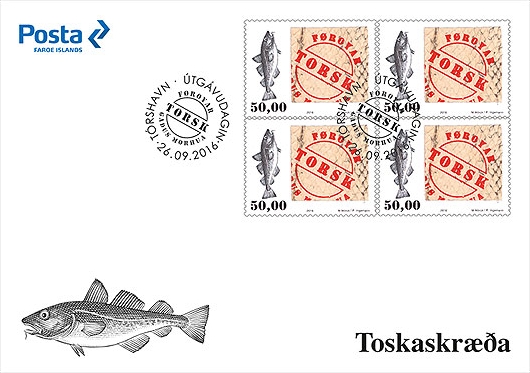
Och så världsnyheten: ett frimärke avbildande en torsk, men också med en bit äkta torskskinn klistrat på märket. Märket är graverat av Martin Mörck och har valören 50 kr. Det är verkligen fråga om ett handarbete och varje märke är unikt.
Som vanligt påminns om att mer information om dessa och tidigare färöiska frimärken finns att läsa på stamps.fo .
